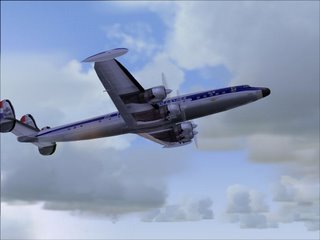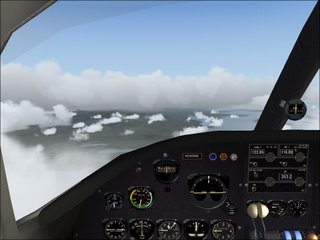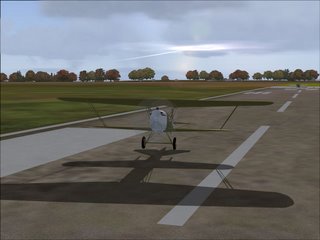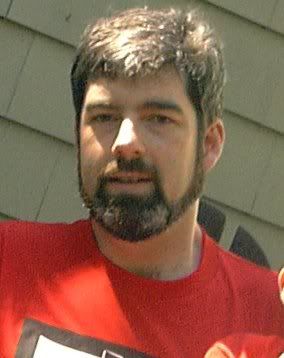
One of the reasons we flightsim is the sheer pleasure of watching airplanes fly. To fully appreciate the form and beauty of the machines one needs to view them dynamically- to see how they move, and to move around them to see them from multiple points of view. A good flight simulator model gives us an appreciation that you cannot get from either a static model or a still photograph. I believe it is second only to witnessing the aircraft flying in person.
One of the most memorable airplane designs is the Lockheed Constellation (the "Connie"). I won't attempt to describe the history of this airplane, you can find that here and other places. The shape is unmistakable, with the lovely porpoise-shaped fuselage and triple tail. So much more character than today's straight-tube airliner designs. This airplane produces am array of visual impressions. It is futuristic, in a nostalgic way, embodying the age in which it which is was created. It is powerful and graceful. At times it reminds me of a fish, and at other times a bird (goose or swan). 
This plane looks awkward on the ground, with the seemingly too long nose wheel assembly. It is this trait that reminds me of the large birds--graceful fliers, but ungainly on their feet.
Once it it in the air it is beautiful to watch. One wants to view it from every angle to see the different profiles it presents.
We are very fortunate to live in an age in which we have a great tool at our disposal for enjoying the aesthetic and technical achievments of the great aircraft designers.
The model shown here is a collabrative effort. The original airplane model is by the prolific freeware designer Mike Stone. An additional person created the lovely paint scheme, and yet another person added a nice instrument panel. (I apologize for not having the other individual's names handy)
Wednesday, June 28, 2006
Connie
Posted by
Runnerdad
at
3:36 PM
1 comments
![]()
Tuesday, June 27, 2006
Compare and Contrast

I've been thinking about how realistic the view from the simulator is or is not. You can find youself really immersed in the experience, and marvel how true to life it looks. But then you can shift your objectivity, look again, and see that it is still kind of cartoony in many ways. I think one of the biggest obstacles to a truly realistic view is the matter of contrast. Computer displays are incapable of the necessary range of contrast. It would be neat if the computer could compensate, for example if it knew you were looking at the instruments on the panel, the scenery would be washed out. If you're looking at the scenery, the panel would become dark. In other words, it would show things the way your eye would see them.
In the image above, I manipulated a screenshot using the GIMP image editing software. I separated the inside and outside views. Then I blurred the outside view a bit, and drastically lowered the brightness of the inside view. The first time I did the outside blur I was amazed at how much it improved the realism. I'd like to try more of this type of editing, but I'd rather spend more of my discretionary time with the yoke or stick, instead of the mouse!
Posted by
Runnerdad
at
9:09 AM
2
comments
![]()
Labels: Musings
Friday, June 23, 2006
In the clouds

Last night I decided to do a longish cross-country flight in the Aero Commander. I flew from Seatle to Port McNeil in British Columbia. I turned out to be an interesting flight due to the weather (I had loaded real-world weather at some point). I was in the clouds for the most part, and really got to enjoy the Flight Simulator weather engine. The shots here show just a glimpse of the many cloudscapes that I got to see. Every once in a while I would break out of the clouds and get a look at the landscape below. I know nothing of the Pacific Northwest, so I couldn't tell where I was at any point.
Overall, my flying was so-so. I printed out the navigation log and flew more than half the flight on course. I was tryind to do the entire flight "inside the plane", that is, not using the map or spot views. However, something must have been missing from the printout because eventually I found myself lost. I was tracking an NDB which I thought would take me all the way to my destination, but found myself passing it with many miles to go. Somehow the next NDB or VOR was missing from my printout. I broke down and pulled out the GPS, and used that to get to where I was going. 
I consoled myself that this was not really cheating, because I was flying without a chart, and no real-world pilot in his right mind would try such a thing.
Despite this navigational failure, the flight was satisfying. I think this was because I had never had a chance to enjoy such an immersion in weather. I did miss seeing more of the ground, so my next leg will have to have more visibility. Anyway, I found another interesting part of the world to explore, if I ever get board of my other favorite places (New England, Alaska, Florida). BC looks like a really neat place to fly around. I wish I had a real (paper) chart for the area (also could use a mesh better than the default).
Posted by
Runnerdad
at
2:57 AM
1 comments
![]()
Thursday, June 22, 2006
New toy, I mean, tool

There's a fantastic new update to one of my favorite freeware airplanes, the Aero Commander by Milton Shupe and his team. I love to fly this plane. A great cruising airplane, but also good for short takeoffs and landings for bush flying fun. I've played with it a bit, but now its time to get serious. I'm contemplating a series of cross-country trips in this bird, doing some actual instrument flying (as opposed to "point south until you see the other airport" kind of flying I usually do). Tonight (Thursday! Flying Night!) I plan on taking off at KSEA (that's the good old default airport, in Seattle) and heading to British Columbia. My ultimate goal is Alaska, but that's going to take a while.
I guess the DC3 going to have to sit in the hangar for now.
Posted by
Runnerdad
at
5:31 AM
0
comments
![]()
Wednesday, June 14, 2006
It's a wonderful world
Just look at this:
This is from my short flight this morning. I was using real-world weather, and actual date and time. I think the clouds here look pretty good, and are a reasonable representation of the actual weather. (There was a moon out this morning, and I saw it in the sim). The airport is Quonset State (KOQU), as portrayed by payware add-on scenery from Flight Scenery. I was flying the default Cessna 172, with improved flight dynamics and add-on repaint, both downloaded for free. The Stearman biplane is another free add-on. The fact that it is sitting there is due to another add-on that allowed me to place custom traffic where I wanted it.
Microsoft is working towards releasing the next version of flight simulator. There's been a lot of talk on the forums like "I hope they improve X, I hope they get Y right this time, I hope we'll finally see Z". I can understand. I have my own wish list (more trees! higher contrast in the clouds!). However, if you think about what we have already, it is pretty astounding. If Microsoft had folded the franchise after the 2004 release, I would still look forward to years, maybe decades, of enjoyment in the world as portrayed in this shot. Let's count our blessings!
Posted by
Runnerdad
at
2:38 AM
0
comments
![]()
Tuesday, June 13, 2006
My non-flying To Do list
A few posts back I gave a To Do list. This consisted of flying tasks-- flights I'd like to take, aircraft I'd like to master, etc. It occured to me that I also have quite a long list of things I want to try that do not directly involve flying. Here's the list off the top of my head (I'm sure I'll forget a few). These have been tugging on my mind, but I am resisting them. I don't have time enough to fly as much as I'd like to, so I really shouldn't let myself get dragged into these things. But still...
So here's the list.
* Scenery design. I've really been itching to make my hometown airport in the sim look like the real thing. I want to do this for both the modern and the Golden Wings versions of the simulator (there's not much difference between the two). This one has the potential of being a huge time sink.
* Repaints. Some simmers are obsessed with paint schemes, either in aquiring or actually creating them. I think I'd like to play around a bit, just for fun. Maybe something silly, just for the kick of seeing my own design flying around in the sim.
* Weather. OK, this one sort of concerns actual flying. I'd like to play around with the weather editor and see what I can do with it.
* Screenshot editing. I love to take and share screenshots. I've done some modest editing work in the Gimp and with Irfanview, but I've only scratched the surface.
* And, of course, reading classic aviation books.
Posted by
Runnerdad
at
5:16 AM
0
comments
![]()
Friday, June 09, 2006
Getting the hang of the DC-3

I think I'm getting a handle on landing this beast. The key --and I know I read this before yet it didn't fully sink in-- is to manage speed with the trim and sink rate with the throttle.
I must be doing this more intuitively on the light planes, because my landing are very good for the most part. Actually, let me modify that a bit. My typical landing in the Cessnas are usally pretty steep (approaching a short runway with nearby obstacles) so I am at idle power and pulling back on the yoke to steepen the descent. Still, the "stick-and-rudder" principles are the same as on larger planes.
Anyhow, with the DC-3 you do not land with idle power, and you don't have the same "lift to spare" sensation. So the technique (I can now speak like an expert :-) ) is to keep the approach speed steady and twiddle with the throttle to keep on the glide slope. Resist the temptation to change the glide slope with the elevators.
For practice I saved a flight on the base leg so I could drill the landing over and over without having to fly around the pattern each time. I resisted doing this for a while, because it felt like cheating. Which is pretty silly, when you think about it. I guess this is evidence of the little fantasy most of us cherish, the one that says "Hey, I could do this in real life! See, I do everything like a real pilot would." But I have to make concessions, because time flies more than I do.
Posted by
Runnerdad
at
6:56 AM
0
comments
![]()
Thursday, June 08, 2006
Its always something new
OK, just when I made up my mind to hunker down and really learn how to fly the DC-3, I got distracted by the St. Exupery flight. Then I got diverted into exploring the geography of the Pyrenees. With the new mesh, this is very exiting terrain to fly over. I have flown the Dehaviland Comet, a Mustang, and a TravelAir. I found a nice airstrip in the foothills , and I set up and saved a flight with the Ford Trimotor, in soggy weather. So far I have flown a couple of circuits, but I am ultimately planning on flying it this weather to some location on the western side of the range. This would be pure dead reckoning and pilotage, as that airplane doesn't even have an ADF.
But this scattered focus can lead to flightsim ennui. So, I think tonight's session (Thursday! the night of my weekly long session) will be concerned primarily with the DC-3 again. I need to keep working the pattern. I'm pretty sure my problems the other night before was due to too high an approach speed. I'm going to work on getting close to 70 knots at touchdown. Once I get good at the pattern, I will start working on navigation. Then, I can do a few short cross-country trips.
Posted by
Runnerdad
at
5:44 AM
0
comments
![]()
Sunday, June 04, 2006
More on Saint Exupery

I managed to finish the flight from Toulouse to Zargosza, Spain. In the image above, you can see me in flight over the Pyrenees. This was the first part of the trip, before the computer crashed. The view was nice, tho the default terrain mesh was a little, well, non-intimidating. Smooth lumpy hills. I wished to see more rocky crags. I have since downloaded and applied a 32 meter mesh, which is much more interesting to fly above, or into.
When I created a new flight starting where the previous one had left off I decided to add a little excitement in the way of the "Building Storms" weather theme. You can see some lightning in this shot. This resulted in some turbulence, and one lightning strike awfully close to the plane, but otherwise a non-eventful trip.
So this excercise by itself didn't fill me with awe and admiration for the men who did it for real. (I guess it would be a little more challenging if I could simulate the experience of being in an open cockpit at 12,000 feet.) I may try to do this again with much less visibility, or without consulting the flight simulator map (which shows the exact position of your aircraft)
Posted by
Runnerdad
at
1:39 PM
0
comments
![]()
Labels: Musings
Friday, June 02, 2006
Following Saint-Exupery's route
I've been reading a bit of Antoine de Saint-Exupery, namely his Wind, Sand and Stars. Those who know this author solely for The Little Prince may not realize that he wrote a fair bit about flying. He's not a pilot's writer exactly, because he doesn't give a lot of specifics about the airplanes (such as make and model) when he writes about them. But inspiring writing nonetheless.
He writes a bit about how he flew a route from Toulouse to Dakar, Morocco. This got me thinking about trying something like that in the simulator. The whole route would take too long for my available time. So I planned instead to fly from Toulouse over the Pyrenees to Spain. I don't know what airplanes he flew this route with. I did see one photo showing him with a medium sized two-seater biplane. A quick search on Avsim turned up what I thought was a reasonable stand-in, a Fokker CVE biplane created by Jens Kristensen, a prolific freeware aircraft designer who specializes in early aviation.
I flew in the Golden Wings version of FS, and started out at dawn with the "Cold Fronts" weather theme. The flight went fairly well. The weather challenged me with a quarter headwind, but otherwise was not any trouble (I sort of hoped for more of a challenge). I gradually ascended to the necessary altitude (about 12000 feet) to clear the mountains. They didn't look too scary with the default terrain mesh. Still, it was nice to cross over and ease into the descent into Spain.
Then I ran into a problem Saint-Exupery never had to deal with. The computer completely froze (after more than an hour of flying). Pretty frustrating. So I gave up, rebooted, and tooled around local scenery in the Piper Cub.
It occured to me later that I have a pretty good idea of where I was when the (computer) crash occured, so it should be pretty easy to set up a flight that will resume at that point. Hopefully in the next post I can give you the result of that effort, and maybe a picture or two.
Posted by
Runnerdad
at
7:14 AM
0
comments
![]()
